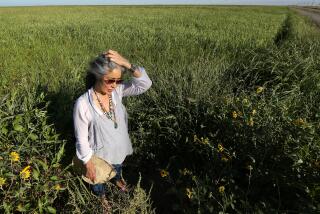How Much Is That Wasabi in the Greenhouse?
- Share via
FLORENCE, Ore. — On a small farm behind unmarked gates, Roy Carver fools a rare green root into thinking this coastal town is really a mountainside in Japan.
He turns a dial and--whoosh!--he has created mist, fog and rain inside 23 greenhouses where he grows wasabi, a spicy garnish used in Japanese cuisine.
Carver’s technology--mind-boggling to most Japanese growers--has made him the largest commercial producer of wasabi outside the Far East. A carefully constructed irrigation system lets him harvest the perennial once a week instead of once a year and at a relatively lower cost.
As the sinus-clearing paste goes mainstream, moving from a garnish to a condiment used in everyday cooking, few are as poised for profit .W Carver. Fresh wasabi fetches more than $100 a pound in Japan and $45 a pound in North America.
Until now, Carver has relied on sales to individuals and high-end restaurants. This month, he is expanding his reach with a line of wasabi dressings available in 5,000 grocery stores nationwide.
“If you asked me 10 years ago, I never would have imagined myself doing this,” said the son of a car salesman.
Carver is an accidental farmer. A property swap gave the former Southern California real estate developer the 52-acre plot where he’s built his farm. He wanted to grow something exotic, something lucrative, something few others could grow.
After careful research, Eutrema wasabi was the perfect choice.
Wasabi’s special growing conditions limit the quantity farmers can produce. A large wasabi farm in Japan is about 11 acres and grows the scraggly plants aboveground in a stream bed where they thrive on nutrients and fast-moving ice water. The top Japanese growers are based in a mountainous region known as Izu peninsula.
In 1991, Carver and a team of engineers and scientists set out to recreate these growing conditions on a seven-acre parcel of the farm in Florence.
Appalled, the Japanese refused to share critical crop information with them.
Carver asked the Japanese wife of a friend to collect the data. Then he hired four independent interpreters to translate books--giving each different chapters so no one would have all the information. (To this day he keeps the translated books locked in security boxes).
Within months, Carver’s team created a sophisticated irrigation system that pumps 3,000 gallons of water a minute through beds of round river rock from which the wasabi plants now grow.
By 1996, after years of experimenting with different varieties, Carver settled on growing the hearty daruma green stem wasabi. Although he won’t reveal how much his company makes each year, Carver said it didn’t take long to start turning a profit with the root’s high price.
When word of this agricultural anomaly got out, weird things began to happen.
Just before dawn one summer morning, an industrial spy scaled the farm’s 8-foot fence, unloaded electronic and surveillance equipment, and attempted to unlock the secrets of the farm.
He didn’t get far. A security guard, roused from a nap, shooed him off the property. But the spy kept on taking photographs from outside the gate. Media reports said that the intruder was from New Zealand.
In another incident, a black Lincoln Continental drove through the farm while three men with cameras snapped pictures from behind their rolled-down windows. Carver still doesn’t know who those men were.
The cloak-and-dagger activity prompted Carver to close the gates and take down any signs indicating the farm’s true identity. Now, only locals and visitors with specific directions can find the farm.
Originally, Carver had planned on shipping the fresh wasabi to Japan, where there is a shortage. But instead he found a market among palate-pleasers such as high-end restaurant Charlie Trotter’s in Chicago and celebrity chef Wolfgang Puck.
From their response and hits on his Web site, https://www.freshwasabi.com, Carver realized Americans weren’t interested in using wasabi on raw fish. They wanted to use it as a condiment or in recipes for mashed potatoes, and cooked fish and meat.
Most Americans have never tasted real wasabi. The dab of pale-green paste served with sushi at Japanese restaurants and grocery stores is usually a combination of horseradish, Chinese mustard and food coloring. It provides a fiery flavor that lingers.
The real stuff, however, hits with an immediate impact, but quickly softens and turns into a sweet, subtle aftertaste that compliments, rather than overpowers, the meal.
The root’s price makes it too expensive to serve to an unappreciative audience. But the taste makes it worthwhile.
Said Carver: “Fresh wasabi, in some ways, is like good wine.”






